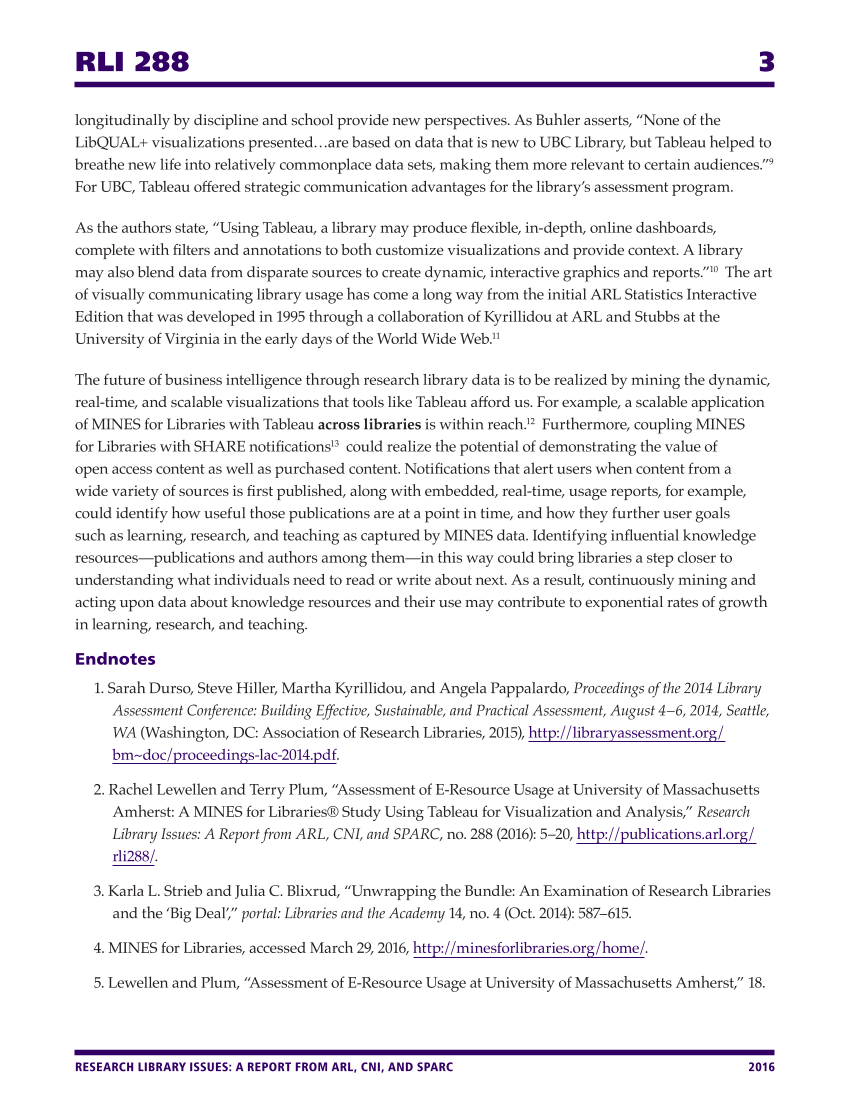RLI 288 3 RESEARCH LIBRARY ISSUES: A REPORT FROM ARL, CNI, AND SPARC 2016 longitudinally by discipline and school provide new perspectives. As Buhler asserts, “None of the LibQUAL+ visualizations presented…are based on data that is new to UBC Library, but Tableau helped to breathe new life into relatively commonplace data sets, making them more relevant to certain audiences.”9 For UBC, Tableau offered strategic communication advantages for the library’s assessment program. As the authors state, “Using Tableau, a library may produce flexible, in-depth, online dashboards, complete with filters and annotations to both customize visualizations and provide context. A library may also blend data from disparate sources to create dynamic, interactive graphics and reports.”10 The art of visually communicating library usage has come a long way from the initial ARL Statistics Interactive Edition that was developed in 1995 through a collaboration of Kyrillidou at ARL and Stubbs at the University of Virginia in the early days of the World Wide Web.11 The future of business intelligence through research library data is to be realized by mining the dynamic, real-time, and scalable visualizations that tools like Tableau afford us. For example, a scalable application of MINES for Libraries with Tableau across libraries is within reach.12 Furthermore, coupling MINES for Libraries with SHARE notifications13 could realize the potential of demonstrating the value of open access content as well as purchased content. Notifications that alert users when content from a wide variety of sources is first published, along with embedded, real-time, usage reports, for example, could identify how useful those publications are at a point in time, and how they further user goals such as learning, research, and teaching as captured by MINES data. Identifying influential knowledge resources—publications and authors among them—in this way could bring libraries a step closer to understanding what individuals need to read or write about next. As a result, continuously mining and acting upon data about knowledge resources and their use may contribute to exponential rates of growth in learning, research, and teaching. Endnotes 1. Sarah Durso, Steve Hiller, Martha Kyrillidou, and Angela Pappalardo, Proceedings of the 2014 Library Assessment Conference: Building Effective, Sustainable, and Practical Assessment, August 4–6, 2014, Seattle, WA (Washington, DC: Association of Research Libraries, 2015), http://libraryassessment.org/ bm~doc/proceedings-lac-2014.pdf. 2. Rachel Lewellen and Terry Plum, “Assessment of E-Resource Usage at University of Massachusetts Amherst: A MINES for Libraries® Study Using Tableau for Visualization and Analysis,” Research Library Issues: A Report from ARL, CNI, and SPARC, no. 288 (2016): 5–20, http://publications.arl.org/ rli288/. 3. Karla L. Strieb and Julia C. Blixrud, “Unwrapping the Bundle: An Examination of Research Libraries and the ‘Big Deal’,” portal: Libraries and the Academy 14, no. 4 (Oct. 2014): 587–615. 4. MINES for Libraries, accessed March 29, 2016, http://minesforlibraries.org/home/. 5. Lewellen and Plum, “Assessment of E-Resource Usage at University of Massachusetts Amherst,” 18.





































